ECS P67H2-A Review: A visit back to Lucid's Hydra
by Ian Cutress on July 21, 2011 9:00 AM EST- Posted in
- Motherboards
- Lucid
- P67
- ECS
3D Movement Algorithm Test - link
The first benchmark ran is actually one I have written. My full time job involves computational chemistry, so this first benchmark uses various algorithms for three-dimensional simulation and movement of independent particles. The algorithms both employ uniform random number generation or normal distribution random number generation, and vary in various amounts of trigonometric operations, conditional statements, generation and rejection, fused operations, etc. The benchmark runs through six algorithms for a specified number of particles and steps, and calculates the speed of each algorithm, then sums them all for a final score. This is an example of a real world situation that a computational scientist may find themselves in, rather than a pure synthetic benchmark. The benchmark is also parallel between particles simulated, and we test the single thread performance as well as the multi-threaded performance.
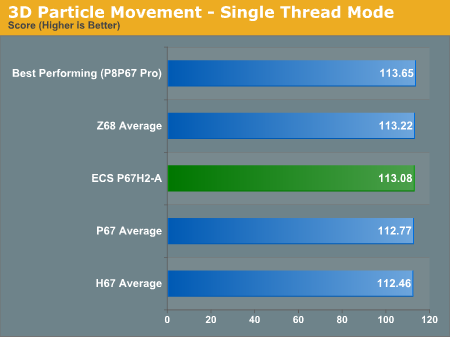
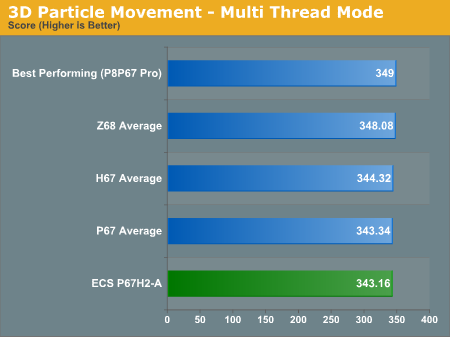
In terms of pure throughput, the ECS board brings up no surprises and falls well within the margin of error compared to other boards.
WinRAR x64 3.93 - link
With 64-bit WinRAR, we compress the set of files used in the USB speed tests. WinRAR x64 3.93 attempts to use multithreading when possible.
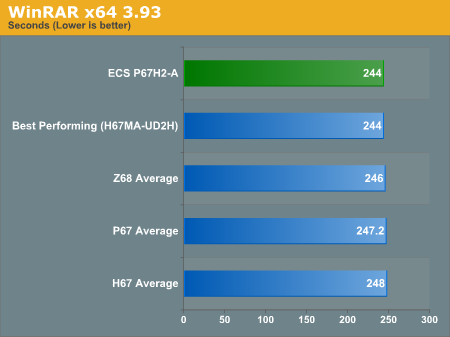
In this test, the ECS board equals our best ever result of 244 seconds.
FastStone Image Viewer 4.2 - link
FastStone Image Viewer is a free piece of software I have been using for quite a few years now. It allows quick viewing of flat images, as well as resizing, changing color depth, adding simple text or simple filters. It also has a bulk image conversion tool, which we use here. The software currently operates only in single-thread mode, which should change in later versions of the software. For this test, we convert a series of 170 files, of various resolutions, dimensions and types (of a total size of 163MB), all to the .gif format of 640x480 dimensions.
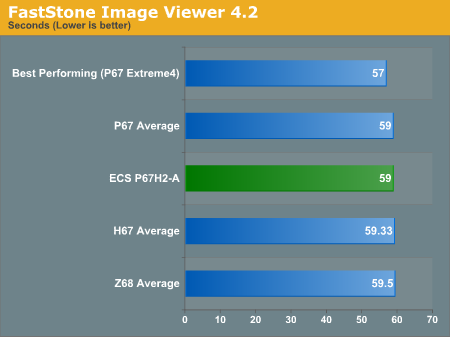
Sorenson Squeeze 6.0 - link
Sorenson Squeeze is a professional video encoder, complete with a vast array of options. For this test, we convert 32 HD videos, each a minute long and approximately 42 MB in size, to WMV 512KBps format. Squeeze can encode multiple videos at once, one for each thread.
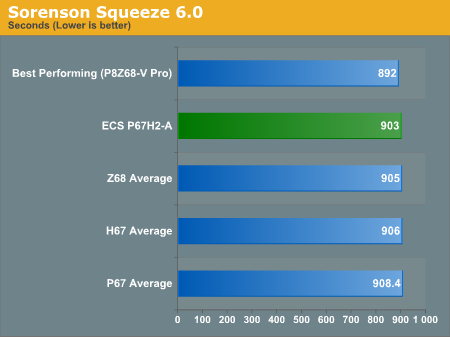










22 Comments
View All Comments
anandtech pirate - Thursday, July 21, 2011 - link
that last photo on the first page makes the board look crooked.also, where's the evo3d review?
Gigantopithecus - Thursday, July 21, 2011 - link
Agreed - some board flexing is to be expected, especially after mounting a massive aftermarket hsf and installation into the case, but that looks a bit ominous for a brand new board straight outta the box! I know it's not terribly reasonable to think less of a board for such a thing, but I can't help but raise an eyebrow as to why a premium board looks like that....Otherwise, thanks for the very thorough review, thanks Ian!
connor4312 - Monday, October 17, 2011 - link
Likely (hopefully) just some lens distortion that wasn't fixed in PS.Hargak - Thursday, July 21, 2011 - link
The word ECS still gives me nightmares. I'm sure things have changed.. I still twitch from flashbacks of early MSI boards..randinspace - Thursday, July 21, 2011 - link
I can't believe you actually ran that many combinations in that many programs for Hydra! It made for quite the fascinating read so great job.ckryan - Thursday, July 21, 2011 - link
are very hit and miss lately.First, if you're a in the business of designing, building, and selling mainbords, why would you try to kick your customers in the [insert place to kick here] with such a prickly, useless UEFI? Further, some of the engineers presumably have sight, so that it left the facory with that kind of graphical uefi is unbelivable. Just looking at the color pictures of the uefi made my eyes hurt with it's yellowish-green and greenish-yellow text on a schizophrenic background. Asus clearly has the (far and away) best graphical UEFI, but the graphical part isn't neccessary if you design the text part is a half way decent fashion. The BIOS and UEFI make or break a board. For instance, Zotac has some good boards with not so great BIOSs, either with dubious or broken or missing functions. Biostar has improved in this area, but was using a text UEFI, then released a grapical upgrade for their 1155's (I have not tried it yet, but have seen some pictures) company that makes boards that should have no excuse for bad BIOS/UEFI designs is Intel (though you could make the case that everything they do should be better). To their credit, they've improved over the last decade substantially. Their DP67BG mainboard had a less than savory UEFI back in January, but has since improved to an almost excellent system. But not graphical, which is okay. I'd rather have a decent text system than graphical one any day of the week, or in ECS's case, never. I just don't get a lot of the decisions mainboard manufacturers are using, especially when this seems like the one area where Taiwanese firms AREN"T "copy and pasting" and just plain stealing from one another.
philosofool - Thursday, July 21, 2011 - link
I honestly don't see the point of GUI BIOS, but I've never used one. The only advantage I can see is building in mouse roll-over stuff so that when I mouse over the menu option, it shows me what's nested in there, but you can do that with arrow key selection too.ckryan - Thursday, July 21, 2011 - link
I think, when done well, a graphical UEFI can provide more information and options. It doesn't actually do anything better per se. In my opinion, no bios provides nearly enough information on settings and options anyway, but some are just abysmal. Even in the mobo's manual you will find vague descriptions which border on absurd. If you do a lot of digging (and you own an Intel extreme series board) you can find Intel's BIOS/UEFI manual which and a performance tuning guide which provides some good guidance about which settings do what and why you would need to use them. If you had only been using AMD, and then switched to a Z/P Sandy Bridge board, you'd probably be a little confused about the options due to the new OC paradigm. I believe that the best motherboard can be ruined with a terrible BIOS or UEFI. UEFI is pretty cool, but if you can't make a good text only implementation, how the hell are you going to make a passable GUI? I'm perfectly happy with a well designed text based UEFI, but I will admit that as much time as I spend with BIOSs and UEFIs, Asus' slick GUI system is clearly in a class by itself. If I were new to the game, I would want something like that on my first build. There just isn't an excuse for terrible BIOS/UEFIs in the year 2011.wifiwolf - Thursday, July 21, 2011 - link
I for instance have been surprised my Asus board gui enables instantly booting from whatever device by clicking in that device in boot section of the bios. Was a nice surprise.Nataku - Friday, July 22, 2011 - link
honestly speaking, for beginner/intermediate users that didn't have to deal with dos, the mouse option does helpbesides, we gotta move forward at some point :P